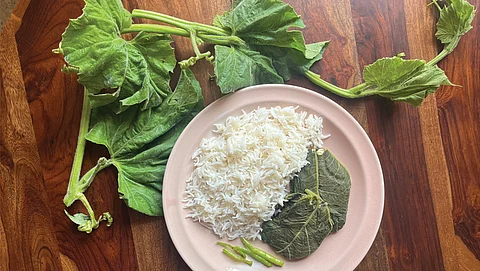

Leafy greens become a food-plate staple in most parts of the country during the winter months, with people relishing palak paneer made with spinach, saag made from mustard greens or even a bowl of raita with bathua (Chenopodium album) leaves. This winter, add to the list another green that is in fact available through the year—the leaves of bottle gourd.
Bottle gourd, known as Lagenaria siceraria in scientific lexicon, is found and consumed across the country. The plant is known as lauki and ghiya in Hindi, dudhi in Marathi and Gujarati, sore kaayi in Kannada, lau in Bengali, zeeth in Kashmiri and charanga and churaykka in Malayalam. Its leaves can vary in size and shape, often round or tri-lobed. They grow on hollow stems with curly tendrils and often have serrated edges. The veins extend from the central line of each leaf and are more prominent on the bottom.
The leaves are a part of traditional recipes such as choddo shak, a dish prepared in West Bengal on Bhoot Chaturdashi, a festival that occurs the day before Kali Pujo or Diwali. The dish is a combination of 14 leafy greens, including the leaves of bottle gourd, pumpkin, mustard, radish, spinach amaranth and fenugreek.
But it is not easy to cook with the leaves. Along with the stems, they need to be de-stringed to remove the hard, spiny parts. And they are often used in recipes with multiple ingredients that are needed in small quantities. This suggests that the recipes are a result of centuries of experiments to find the perfect combination of ingredients (see recipe for lau saag chhochori).
The leaves are also used for steaming food as they are large and can be easily made into an edible parcel. Wrapping marinated fish in them ensures the flavour of the spice is not lost during steaming. The leaves are also used to prepare a dish with cottage cheese called chenna paturi, which is eaten with boiled rice (see recipe for chenna paturi). When ingredients such as lemon rind are added to the chenna, the leaf helps preserve the volatile ingredients in the cheese and enhances the flavour.
Bottle gourd belongs to the cucurbitaceae family and grows across tropical regions in Africa, Asia and the Americas. A March 2024 study, published in New Phytologist by researchers from the Boyce Thompson Institute (a research non-profit under Cornell University) and the US Department of Agriculture, says that the plant originated in the southern parts of Africa around 12,000 years ago and then spread to the Americas and Eurasia. For this study, the team generated a comprehensive map of bottle gourd’s genome variation by analysing the genomes of 197 varieties of the plant from around the world.
In India, there is evidence that bottle gourd was consumed as a vegetable since 2,000 BCE, according to a paper published in Asian Agri History in 2011. The juice of this fruit is prescribed in Ayurveda for its cooling effect and benefit to heart health. It is also consumed for controlling diabetes mellitus, hypertension, liver diseases, weight loss and other associated benefits.
Traditionally, the leaf extract is applied for treating baldness and headaches. The leaves are also mixed with coconut oil or salt and applied to treat tumours and skin irritation. The juice extracted from leaves is also helpful in curing jaundice.
There is not much information on the nutritive value of the leaves. A study on the South African varieties of the plant looked at the nutritive value of various landraces and hybrids being cultivated in the country and whether these could help meet the nutritional requirements of the population. The researchers found that the leaves contain high amounts of calcium, phosphorus, potassium, magnesium and iron. All varieties met the recommended dietary allowance for all nutrients. The study was published in the Journal of Human Ecology in September 2015.
Bottle gourd leaves, therefore, make for a unique, healthy addition to the food plate.
Ingredients
Bottle gourd leaves: 4
Fresh cottage cheese: 1 cup
Kasundi (mustard sauce): 2 tbsp
Finely grated coconut: 3 tbsp
Green chillies, chopped: 3-4
Turmeric powder: 1/2 tsp
Mustard oil: 2 tsp
Salt to taste
Method
Remove the hard parts of the leaves, wash and keep them aside. Mix all the other ingredients in a bowl. Knead the mixture till it is smooth and divide it into four parts. Take a leaf and place one part of the chenna mixture on it. Flatten the mixture and place a few pieces of chilli on top of it. Fold the leaf to make a square parcel and tie it with a thread, if needed. Steam the parcel for 10-15 minutes till the leaves are soft. Enjoy the parcel, including the leaf, with hot rice.
Ingredients
Bottle gourd leaves: 10, on the stem
Bori (dried lentil dumplings): 10
Potato: 1 (cubed)
Sweet potato: 1 (cubed)
Pumpkin: 1 cup (cubed)
Panch phoron: 1 tbsp
Whole red chillies: 3
Mustard oil: 3 tbsp
Poppy seeds: 1 tbsp
Mustard seeds: 1 tbsp
Green chillies: 2
Turmeric: 1 tbsp
Sugar: 2 tsp
Salt to taste
Method
Fry the bori in a wok of oil till they are golden brown and keep them aside. Cook the red chillies, panch phoron, cubed vegetables, salt and turmeric for five minutes. Add chopped greens and cook for 10 minutes. Add a cup of water and cook till all the vegetables are done. Mix in the sugar and bori and serve with rice.
This was first published in the 1-15 January, 2025 Print edition of Down To Earth